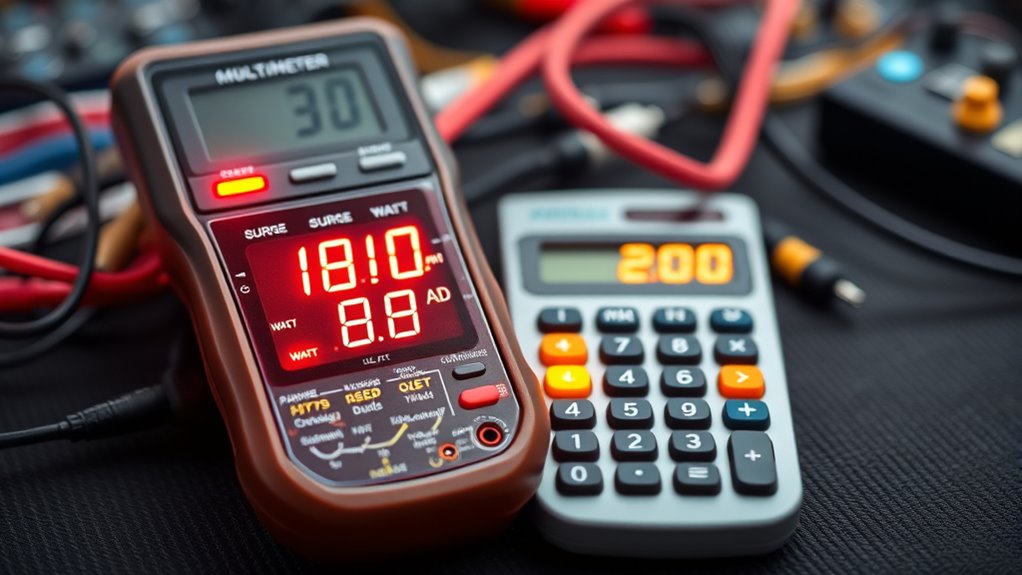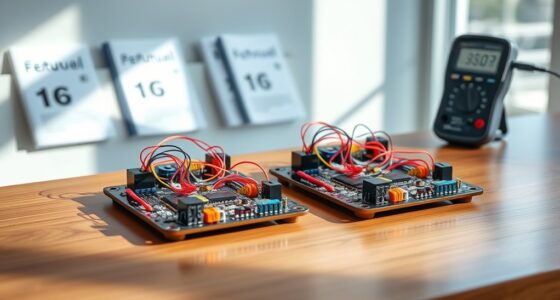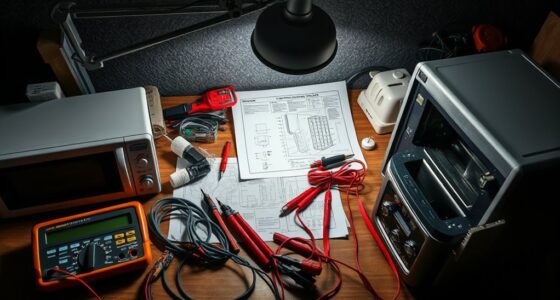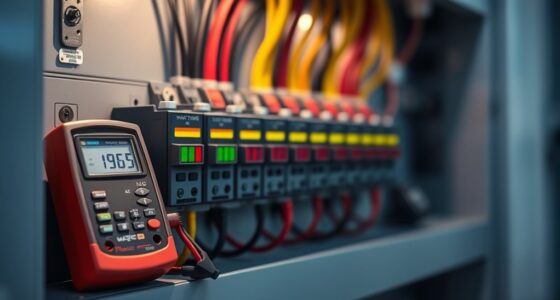When distinguishing surge and running watts, you need to understand that surge watts are the extra power your appliances require at startup, especially for motors. Running watts are the power needed during normal operation. To avoid damage or inefficiency, use a calculator that accurately separates these two. Do not rely solely on starting wattage or overestimate running watts. Keep these tips in mind, and you’ll make smarter decisions—more helpful insights are ahead.
Key Takeaways
- Understand that surge watts are temporary power needed at startup, while running watts are continuous power during operation.
- Use a calculator to accurately determine total surge and running watts for all appliances to prevent overloads.
- Do not ignore surge watt requirements; underestimate can cause equipment damage or failure.
- Do not rely solely on running watts; include surge wattage to ensure proper generator sizing.
- Do this: add up all devices’ surge and running watts separately for precise power needs; avoid common estimation errors.
Understanding the Difference Between Surge and Running Watts
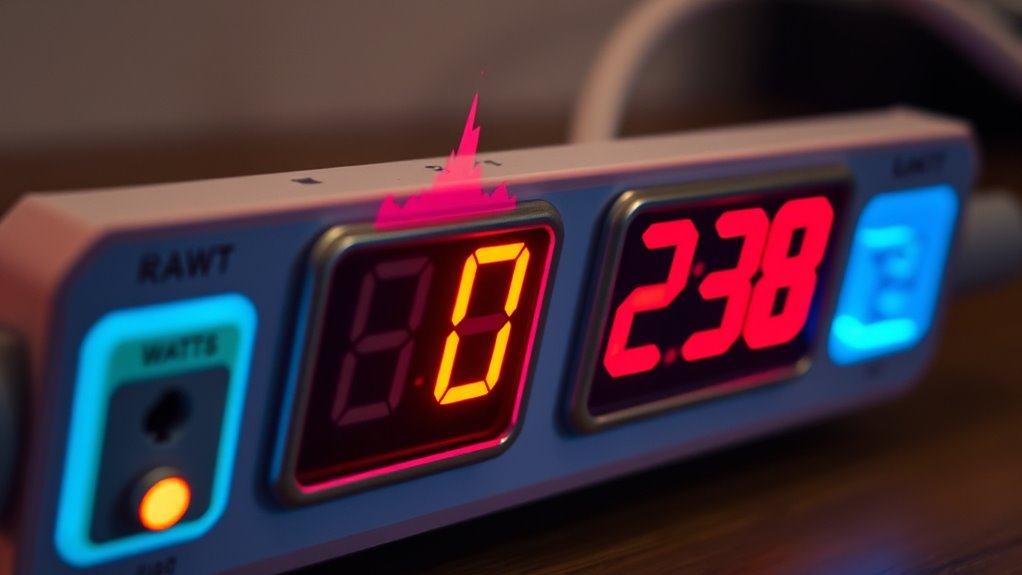
When choosing a generator or power supply, it’s important to understand the difference between surge and running watts. Surge watts refer to the extra power needed to start appliances with motors or compressors, like refrigerators or power tools. Running watts, on the other hand, are the continuous power your device uses during normal operation. Knowing this helps you select a generator that provides adequate appliance compatibility, preventing overloads or damage. It also impacts power efficiency, as a generator that matches your load needs runs more smoothly and uses fuel more effectively. Properly calculating size restrictions ensures your generator can handle all your appliances safely and reliably without unnecessary wear or energy waste. By understanding the distinction, you ensure your appliances operate safely and reliably without unnecessary wear or energy waste. This knowledge helps you make smarter decisions when sizing your power source.
Why Accurate Power Ratings Matter for Your Appliances
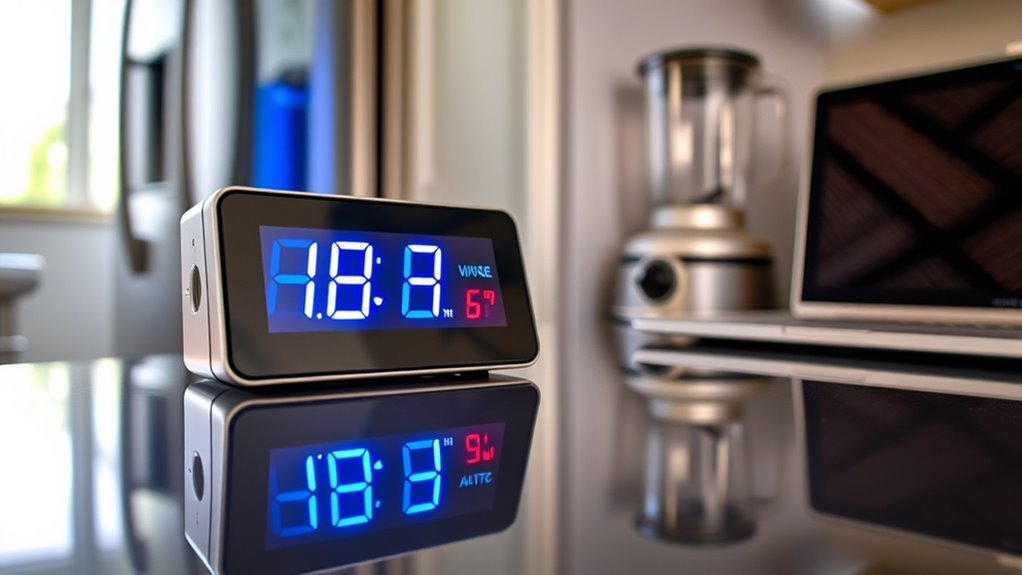
Accurate power ratings help prevent your appliances from damage caused by overloads or insufficient power. When you know the correct surge and running watts, your equipment will function properly and last longer. Plus, matching power needs can save you money on energy costs over time. Understanding industry trends can also help you make informed decisions when selecting or upgrading appliances.
Prevents Equipment Damage
Using the wrong power ratings can lead to serious damage to your appliances. When voltage stability isn’t maintained, appliances may experience power surges or drops that strain their components, causing overheating or failure. Accurate surge and running watt ratings help guarantee your equipment receives the right amount of power, preventing overloads. Additionally, understanding your device’s battery capacity is essential, especially for portable appliances or backup systems. If the power supply isn’t aligned with your device’s needs, it can quickly deplete batteries or damage internal circuits. Correct power ratings act as a safeguard, reducing the risk of electrical stress that can impair performance or shorten lifespan. Properly matching power ratings with your appliances’ requirements ensures optimal operation and longevity. Prioritizing precise calculations keeps your appliances safe and functioning at their best over time.
Ensures Proper Functionality
Proper power ratings guarantee your appliances operate smoothly and as intended. Accurate wattage calculations help maintain proper power factor, ensuring your devices function efficiently without overloading. When power ratings are precise, voltage stability is preserved, preventing fluctuations that can disrupt performance. If your appliance’s power needs are underestimated, it may underperform or shut down unexpectedly. Overestimating can cause unnecessary strain on your power source, leading to potential damage. Correct surge and running watt ratings ensure your equipment receives consistent, reliable power, allowing motors and electronic components to work at their best. This prevents issues like overheating or reduced lifespan. Additionally, understanding asset division principles can help you plan for future financial stability after your purchase or upgrade. Ultimately, understanding and matching power ratings safeguards your appliances and guarantees they perform at their best without compromising safety or efficiency.
Saves Energy Costs
When your appliances have correctly rated wattages, you avoid wasting energy by preventing unnecessary power consumption. Accurate power ratings help ensure your devices only draw what they need, supporting energy conservation. This prevents overloading your system and reduces electricity bills, leading to significant cost savings over time. Knowing the true surge and running watts allows you to choose the right size generator or power source, avoiding excess capacity that wastes energy. Properly rated appliances run more efficiently and prevent unnecessary strain on your electrical system. By focusing on precise wattage requirements, you optimize energy use, cut down on waste, and lower your monthly expenses. Additionally, understanding feature Buddies can help you better interpret appliance specifications and select the most suitable power solutions. Ultimately, accurate power ratings empower you to make smarter, more economical choices for your home’s energy needs.
How to Determine Your Appliance’s Starting and Running Power Needs
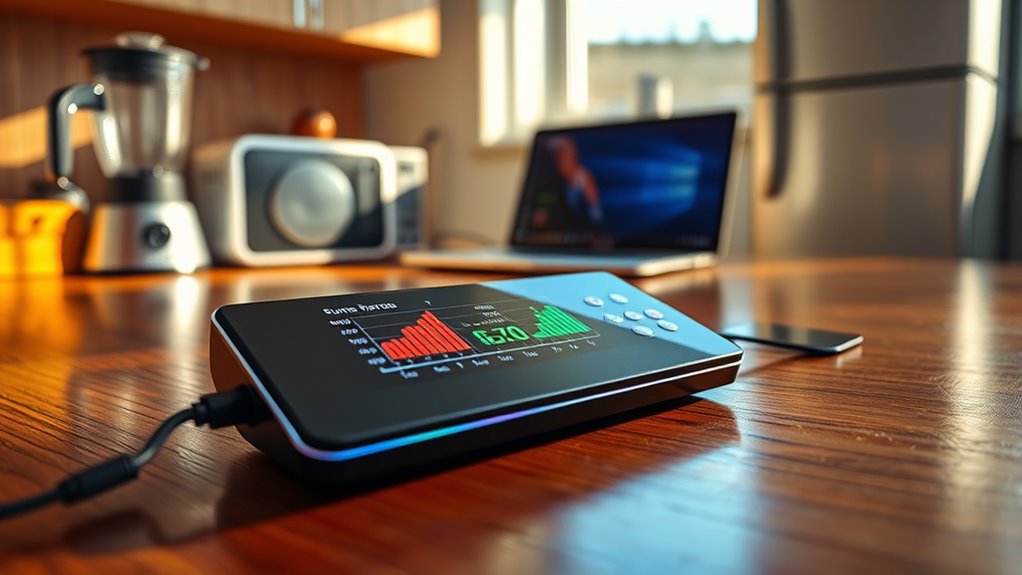
To accurately determine your appliance’s power needs, you need to identify both its starting and running wattages. This ensures you select a power supply compatible with your device’s demands and maintain appliance efficiency. First, check the appliance’s label or user manual for wattage ratings. Next, follow these steps:
- Measure the initial surge using a watt meter during startup.
- Record the continuous power draw during normal operation.
- Note the difference between starting and running wattages.
- Use these figures to match your power source’s surge and running watt capacities.
- Keep in mind that understanding spiritual energy and its fluctuations can also help you recognize when appliances or devices are experiencing energy surges or drops, ensuring safer and more efficient use.
Understanding these values helps prevent overloads and guarantees your appliance runs smoothly. Accurate wattage readings are essential for proper power supply compatibility and ideal appliance performance.
Common Mistakes When Using a Surge vs. Running Watts Calculator
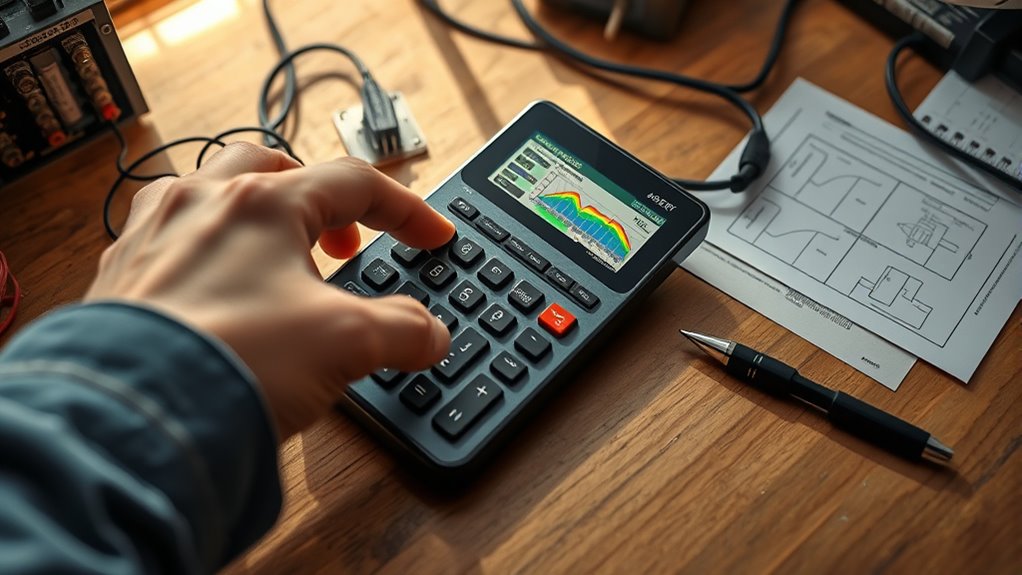
Many users make the mistake of relying solely on the starting wattage when sizing their power sources, which can lead to overloads or insufficient power during appliance startup. Ignoring power fluctuation risks, they underestimate how much surge wattage is needed, potentially damaging appliances or causing system failures. Additionally, not considering appliance compatibility can result in choosing a power source that can’t handle the peak demands of certain devices. This oversight might lead to appliances not functioning properly or experiencing frequent shutdowns. Always remember to account for both surge and running watts accurately, and guarantee your power source matches the specific power requirements of your appliances. Properly understanding power ratings can help you select the right equipment and prevent overloads, prolongs equipment life, and assures optimal performance.
Step-by-Step Guide to Calculating Your Power Requirements
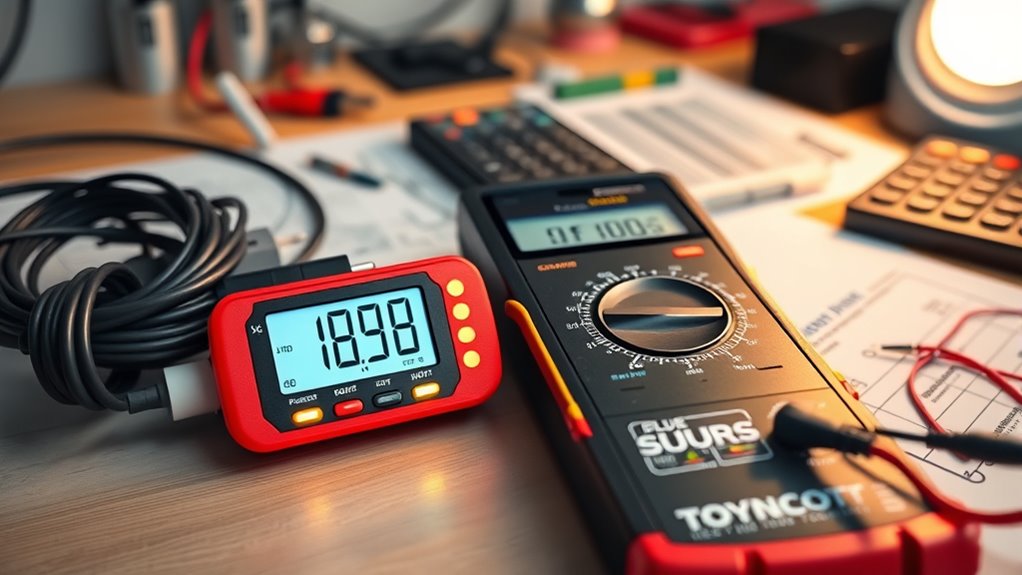
Understanding how to accurately calculate your power requirements guarantees you select the right size power source for your appliances. Start by listing each device’s starting (surge) and running wattages. Next, consider the power factor, which affects how efficiently your appliances use electricity, and verify your calculations account for voltage stability in your area. To get a precise estimate:
Accurately calculating your power needs ensures reliable appliance operation and system efficiency.
- Add up all the running watts of your appliances.
- Factor in the surge watts for devices with high starting power.
- Divide the total wattage by the power factor to find the actual power needed.
- Ensure your power source can handle voltage fluctuations for voltage stability.
- Remember that understanding surge vs running watts helps prevent overloads and equipment damage.
This process helps you avoid underestimating power needs and ensures your system operates smoothly.
The Impact of Underestimating Surge Power
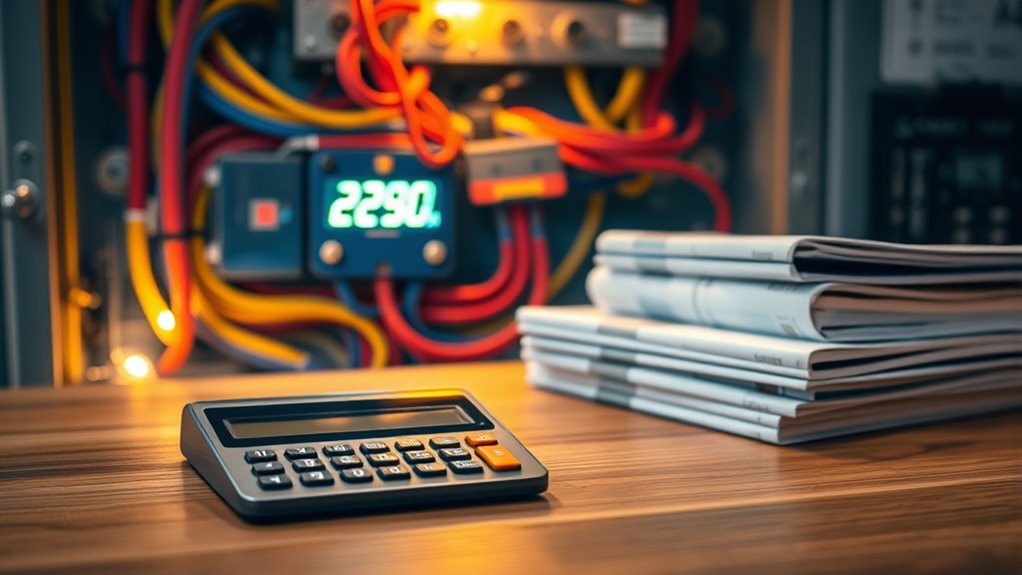
Underestimating surge power can lead to equipment damage or failure because your devices might not get the quick power boost they need. This can cause frequent power failures, disrupting your operations and risking costly repairs. Making sure you account for the surge helps protect your equipment and keeps everything running smoothly. Properly understanding power requirements is essential for effective surge protection and overall system security.
Equipment Damage Risk
When you underestimate the surge power required by your equipment, you risk causing immediate or long-term damage. This can compromise electrical safety and reduce power efficiency. Damage may occur to sensitive components, leading to costly repairs or replacements. To avoid this, keep these points in mind:
- Overloading circuits can cause overheating and potential fire hazards.
- Insufficient surge capacity stresses devices, shortening their lifespan.
- Repeated stress may lead to permanent damage, affecting overall equipment performance.
- Undervaluing surge power increases the risk of electrical safety issues, putting you and your property at danger.
- Properly accounting for surge protection ensures your devices are safeguarded against unexpected power spikes, maintaining their longevity and safe operation.
Frequent Power Failures
Frequent power failures often result from relying on insufficient surge capacity, which causes your electrical systems to trip or shut down unexpectedly. When your surge wattage isn’t enough to handle quick power spikes, your equipment may turn off during a power outage or sudden load increase. This not only disrupts daily activities but also hampers emergency preparedness, especially if you rely on backup devices like generators or UPS systems. Underestimating surge power can lead to repetitive outages, making it harder to maintain critical devices during blackouts. To improve reliability, verify your surge capacity exceeds the maximum startup wattage of your essential appliances. Doing so helps prevent unnecessary power failures, keeping your systems running smoothly and supporting your emergency preparedness efforts during unexpected power outages.
How Overestimating Running Watts Can Lead to Overspending

Overestimating the running watts your appliances or equipment need can lead to unnecessary expenses. When you overestimate, you might buy a more powerful generator than necessary, increasing costs. Proper power measurement helps guarantee appliance compatibility without overspending.
To avoid this, keep in mind:
- Your true power needs are often lower than estimated, leading to higher upfront costs.
- Oversized generators consume more fuel and require larger, more expensive units.
- Overestimating can cause misjudgments in appliance compatibility, risking damage or inefficiency.
- Accurate calculations can save you money by matching the generator size to actual needs, preventing waste and ensuring smooth operation.
Balancing your power measurement ensures you won’t overspend on unnecessary capacity.
Choosing the Right Generator Based on Your Power Needs
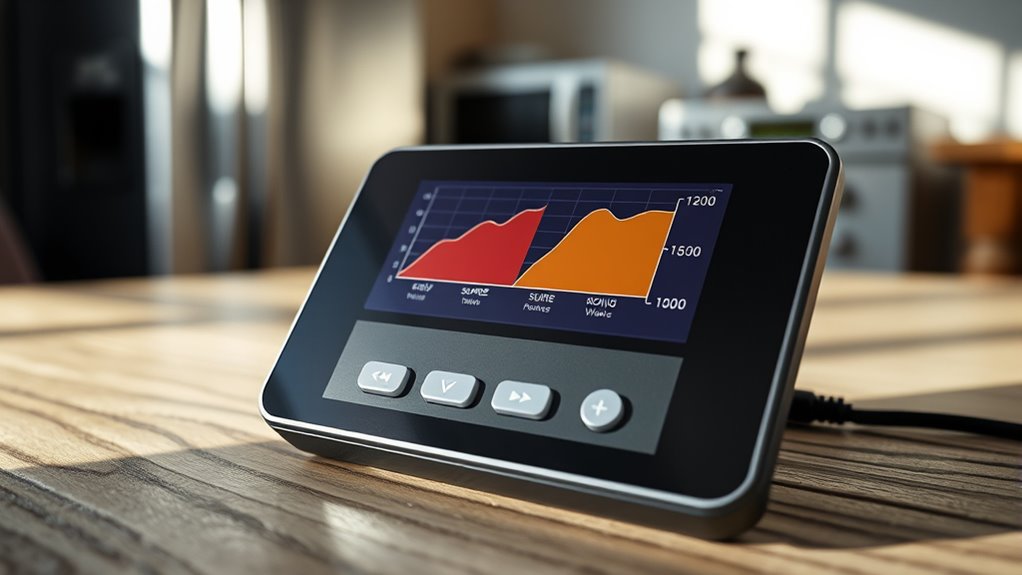
Choosing the right generator starts with accurately evaluating your power needs. You need to list essential appliances and their surge and running watts to determine the total power capacity required. This guarantees your generator can handle startup surges without overloading. Remember, a generator with proper maintenance will run more reliably when you need it most, especially during power outages. Consider your power outage preparedness by choosing a unit that provides enough wattage for critical devices like refrigerators, lights, and medical equipment. Avoid overspending on a generator that exceeds your needs, but also steer clear of one that’s underpowered. Knowing your exact wattage requirements helps you select a generator that offers top-notch performance, reliability, and ease of maintenance, ensuring peace of mind during emergency situations.
Practical Tips for Using Surge and Running Watts Data Effectively

When using surge and running watt data to select a generator, it’s important to understand how these numbers affect your equipment’s performance. Accurate power measurement guarantees your appliances operate smoothly without overloads. Here are practical tips:
- Always check appliance ratings to know the surge and running watts needed.
- Use surge watt data for initial startup, but focus on running watts for continuous operation.
- Add a safety margin—around 15-20%—to handle unexpected power spikes.
- Keep a detailed list of your appliances’ power requirements to match them with your generator’s capacity.
These steps help you interpret power measurement data correctly, preventing overloading and ensuring your appliances run efficiently. Proper understanding of surge and running watts guarantees reliable performance and longevity for your equipment.
Do This, Not That: Best Practices for Power Planning and Safety

Make sure your power planning is based on accurate calculations to avoid surprises down the line. Don’t overload circuits, as it can cause damage or safety hazards. Regular safety inspections are key to catching issues early and keeping your setup safe.
Prioritize Accurate Calculations
To guarantee your power setup is safe and reliable, prioritize accurate calculations of surge and running wattages. Properly estimating these values ensures energy efficiency and appliance compatibility, preventing overloads.
Here are key tips to achieve this:
- Always check manufacturer labels for precise wattage ratings.
- Include startup surge wattage when calculating total load.
- Use a reliable wattmeter to measure actual energy consumption.
- Double-check calculations to avoid underestimating power needs.
Accurate calculations help you avoid overloading circuits, reduce energy waste, and ensure your appliances operate smoothly. Remember, misjudging wattage can compromise safety and shorten equipment lifespan. Prioritizing precision in your calculations makes your power system more dependable and efficient.
Avoid Overloading Circuits
Accurate wattage calculations are the foundation of a safe power setup, but they must be paired with proper circuit management to prevent overloads. Overloading a circuit increases the risk of power surges and wattage overloads, which can damage devices or cause fires. To avoid this, don’t connect multiple high-wattage appliances to a single outlet. Use the table below to help distribute your devices safely:
| Device Type | Max Wattage per Circuit |
|---|---|
| Small appliances | 1,200W |
| Power tools | 1,500W |
| Heavy equipment | 1,800W |
Keep track of total wattage and stay under these limits to prevent dangerous power surges and ensure your circuit remains safe.
Regular Safety Inspections
Regular safety inspections are essential for maintaining a reliable and hazard-free power system. During inspections, you should check circuit breakers to ensure they trip properly and haven’t become faulty. Inspect power outlets for signs of damage, wear, or corrosion that could cause short circuits. Regularly test grounding connections to prevent electrical shocks. Additionally, verify that all wiring is intact and free from fraying or overheating.
To keep your system safe, remember:
- Test circuit breakers periodically to confirm proper function.
- Replace damaged or loose power outlets immediately.
- Ensure wiring is secure and not compromised.
- Keep inspection records for future reference.
These steps help prevent electrical failures, protect your equipment, and ensure safety for everyone involved.
Frequently Asked Questions
How Often Do Appliance Power Ratings Change Over Time?
Power ratings for appliances can fluctuate occasionally, especially as appliances age or undergo repairs. Over their lifespan, you might notice small changes due to wear and tear or updates in technology. These power rating fluctuations are usually minimal but can impact energy usage. To verify safety and efficiency, it’s good to check your appliance’s power ratings periodically, especially if you notice changes in performance or energy bills.
Can Environmental Factors Affect Surge and Running Watt Measurements?
Like a ship steering unpredictable seas, environmental influences can impact your surge and running watt measurements. Factors such as temperature, humidity, and altitude cause power fluctuations, making appliances draw more or less power than usual. These conditions can skew your readings, so it’s essential to take environmental influences into account when calculating your power needs. Stay aware of these variables to ensure your appliances operate smoothly and safely under changing conditions.
Are There Industry Standards for Measuring Appliance Wattage?
Yes, industry standardization exists for measuring appliance wattage to guarantee wattage accuracy across devices. Organizations like the IEEE and UL set guidelines to maintain consistent testing methods, which help you compare appliances reliably. By following these standards, manufacturers provide accurate wattage ratings, so you can confidently determine the power needs of your appliances and select the right generator or power source for your specific requirements.
How Do I Adjust Calculations for Appliances With Variable Power Draws?
Imagine you’re a pioneer steering fluctuating loads. To adjust calculations for appliances with variable power, you need to consider their peak surge wattage and typical running wattage. Measure the highest surge wattage during operation and use an average or worst-case scenario for your calculations. This way, you account for variable power and ensure your generator can handle fluctuating loads without overloads or interruptions.
What Safety Margins Should I Include in My Power Calculations?
You should include a safety buffer of about 20-25% in your margin calculations to account for unexpected power surges or startup currents. This safety margin helps prevent overloading your generator or circuit. Always remember to take into account the appliance’s surge wattage and add extra capacity for any additional devices you might connect later. Incorporating a safety buffer ensures reliable, safe operation and prolongs your equipment’s lifespan.
Conclusion
Understanding the difference between surge and running watts is your key to avoiding surprises and ensuring your appliances run smoothly. Think of your power needs as a dance—getting the timing right keeps everything in sync. By following accurate calculations and best practices, you’ll steer clear of overspending and safety risks. Remember, a well-planned setup is like a sturdy bridge—you can confidently cross to every success without falling into costly pitfalls.
